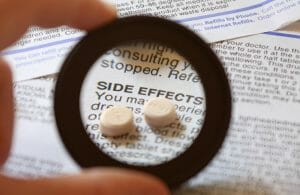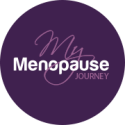How you live your life can influence your health in a big way! Unhealthy eating, lack of exercise and too much stress impact your body.
As with all medical therapies, hormone replacement therapy (HRT) for women has risks, but a poor lifestyle is said to be just as risky. Statistics say more women die of a stroke because of poor lifestyle compared to breast cancer caused by HRT.
HRT has had a negative rap going on for years. Many early studies questioned the safety of this therapy. Most results of these studies explained that prolonged use of HRT might cause breast cancer and heart disease.
This health scare created a stigma for many years. Many menopausal women stayed away from using HRT for this reason. Know more about early HRT studies in our FACT BOX below!
Over the years, the medical field still has different views on HRT. The North American Menopause Society (NAMS) says that there’s still much to learn about HRT, and more studies must be done.


What are the Two Types of Hormones Used in HRT?
Hormone replacement therapy for women (HRT) is a conventional method of replenishing hormones that you lack inside the body. The most common reason is hormonal fluctuations because of menopause. HRT is also known as menopausal hormone treatment (MHT).
HRT relieves menopause symptoms and thereby improves your quality of life. Estrogen, progesterone, testosterone and DHEA are examples of hormones you receive in HRT.
There are two types of hormones used in HRT:
1. Synthetic Hormones – hormones which are commercially prepared. Examples include Premarin, Progestins, Provera and Prempro. Progestins are synthetic progesterone. Provera is also synthetic progesterone, and it’s widely sold synthetic hormones in the market. Prempro, on the other hand, is a combination of estrogen and progestin.
2. Bioidentical Hormones – hormones come from plant-based sources such as yam and soy. Examples of bioidentical estrogen hormones are Estrace, Ogen and Climara. Prometrium, Crinone and Prochieve.
Bioidentical hormones have a similar molecular structure to hormones produced by our body. Experts say this is the reason they blend well.
OB-GYN Dr. Christiane Northrup says bioidentical hormones are “theoretically” safer than synthetic hormones. Bioidentical Hormone Replacement Therapy (BHRT) has made a name for itself in recent years. The North American Menopause Society (NAMS) says that 1.4 million women, mostly menopausal, use BHRT.
HRT and BHRT differ in four simple ways: the goal of therapy, preparation, care during treatment and accessibility.
In the goal of therapy, HRT is for the quick relief of symptoms and disease prevention. BHRT balances hormones and improves the quality of life.
For the preparation, HRT is commercially prepared. For this reason, hormones are in standard doses. BHRT is given in individualized doses according to your needs. But it’s worth mentioning that there are bioidentical hormones that are also commercially prepared.
As for care during therapy, HRT needs regular monitoring because of the risk of side effects. Examples include migraines, gut issues, swelling, cramps and vaginal bleeding. BHRT requires little to no therapy care.
Finally, both HRT and BHRT need a doctor’s prescription when it comes to accessibility. I mentioned that BHRT has some pre-dosed hormones – you need a prescription to get them.
Compounded bioidentical hormones can be bought without a prescription. In the pharmacy, a compounding pharmacist who prepares personalized doses for you.
The FDA doesn’t regulate compounding pharmacies. But in some states, the Board of Pharmacy monitors them. On one hand, the FDA regulates hormones in HRT such as content, dose, quality and sterility.
Besides these differences, it’s important to know that HRT may give you relief within days after starting it. BHRT can take weeks, while natural hormones from herbs may take longer.
Dr. Christiane Northrup talks about HRT and BHRT in this video and how they work in the body. Know why the hormone Premarin is not good for you and get a list of some of her recommended bioidentical hormones, which she thinks are safe and effective [5:06]:
Different Forms of HRT and BHRT
HRT and BHRT are available in nasal sprays, pills or tablets and skin gel and patches. They also come in vaginal creams and tablets, vaginal rings and suppositories.
Experts say HRT used locally doesn’t increase the risk of cancers or heart disease. Creams and patches don’t pass organs like your gut or liver, so they are less potent. For example, one study (2018) says that the use of vaginal estrogen doesn’t increase the risk of breast cancer. The reason is that vaginal estrogen comes in lower doses than oral estrogen.
Pills and tablets are a different story. They pass through your liver and might increase the risk of blood clots. But if you live healthily and don’t sit all day, experts say it lowers the risk.
Even if tablets and pills come with risks, most women take them because it’s easy. However, the use of patches, nasal sprays and gels can cause allergies for some women.
HRT is a controversial topic in the world of medicine. Many experts debate whether it’s safe or not. If you’re curious how this ruckus all began, let’s go back in time. Read the rest of the article and check out a rundown of HRT’s history in our FACT BOX!
The Benefits and Risks of Hormone Replacement Therapy for Women
Like any other conventional therapy, hormone replacement therapy for women has benefits and risks.
Our doctors have a say whether we need HRT or not, but we are a big part of the decision-making process! For this reason, it’s good to understand how HRT works.
To maximize the benefits of HRT, NAMS says that our plan of care should be tailored to our unique needs. This means identifying appropriate HRT type, dose and formulation. How we take HRT and how long is also important. To reduce risks, regular evaluation of HRT use is also essential.
NAMS adds that the benefits of HRT outweigh the risks for women aged 60 and under. It can also be good if you’re within 10 years of menopause onset.
If you follow the above guidelines, experts say HRT can reduce the risk of Alzheimer’s disease, osteoporosis and dementia. Studies claim hormone therapy for women is only effective during the period it is used. Once you stop, HRT loses its effect in the body.
Here are some of HRT’s top benefits!
- Reduces vasomotor symptoms such as hot flashes and night sweats.
- Makes you sleep better and relieves muscle aches and pains.
- Lessens mood swings and depressive episodes.
- Relieves vaginal dryness and atrophy. Improves overall sexual function.
- Reduces the risk of osteoporosis, heart diseases and colorectal cancer.
- Increases the production of collagen which slows down aging.
- Lowers the risk of diabetes, because insulin works better with normal levels of estrogen.

On the other hand, here are HRT’s risks:
- Increases the risk of breast cancer (2016), especially when taking combined HRT (estrogen + progestogen) for the long term.
- Increases the risk of endometrial cancer (2013), but only when using estrogen without progestin.
- Increases the risk of blood clots (2019) when taken in systemic forms, like tablets and capsules. No increased risk when you use patches or gels.
- Increases the risk of dementia (2012) if women take HRT after the age of 60.
Besides the type, dose, duration and route, the risks also depend on whether another hormone is used. Progestogen is a hormone that increases the risk of HRT. Women who started HRT more than 10 to 20 years from menopause onset also have higher risks.
Some experts say that if you receive HRT after 60, your body might no longer take the hormones. It might just cause more side effects than symptom relief. When your body loses a function, it isn’t easy to restore it. Science says, “if you don’t use it, you lose it!”.
Do You Know Your Estrogen Window?
Many experts say that it’s safe to take HRT 5 to 7 years after menses. Dr. Mache Seibel, a doctor specializing in women’s health, supports this claim.
Another menopause expert, Dr. Barbie Taylor, or more popular as Menopause Barbie, also believes in the estrogen window. She fondly calls it “the estrogen window of opportunity.”
Health practitioners have different views about the estrogen window. The length may vary on who you ask. Everything should be considered before taking HRT.
There’s no one-size-fits-all solution. A thorough evaluation of your health history, genetic predispositions and lifestyle is essential.
Dr. Barbie has a great video where you get plenty of information about the estrogen window. She’s really good at explaining what it means [34:51]:
5 Special Information to Look into When Considering HRT!
I don’t particularly appreciate mixing health and politics into one. However, for HRT, there is five back-door information that you need to be aware of before deciding to take the therapy.Remember, big companies put money as their first interest. Their primary goal is always to get profits for their shareholders. This is true for all medications. It’s important that you look into research findings and results. Here are 5 factors to consider:
- Who is paying the research?
- Do conclusions coincide with results?
- What was tested and how was it done?
- Do results state real health effects or only opinions?
- Is it an observation or randomized controlled blind study?
You can check out a lot of studies in the US National Library of Medicine National Institutes of Health and Science Hub. Alexandra Elbakyan, a researcher, built Science hub or sci-hub. It’s a website that’s free from journal paywalls and gives you access to scientific papers.
Is There a Non-Hormone Option for Me?
There are non-hormonal products on the market. One that I read about and tried myself is Femarelle. It is a popular product used by many women in Europe. It’s now sold in the United States too.
Femarelle comes from fermented soy extract with ground linseed. Many experts say that it’s one of the best menopause supplements because of its natural ingredients, making it safe.
Renowned gynecology specialist, professor and chairman of the European Society of Gynecology, Dr. Andrea Genazzani, believes that it’s one of the best non-hormonal options for menopausal women. I used Femarelle, and I found it helpful in relieving symptoms. However, women react to supplements in different ways; always check with your doctor!
More women also use phytoestrogens to relieve symptoms. These are estrogens which come from plants. Phytoestrogens are weaker forms of estrogen, but they can still reduce menopause symptoms.
The Takeaway!
Besides relieving your menopause symptoms, some experts say that HRT is right for your future health.
In the 1900s, only 5% of the population lived after their 50th birthday. Today, we live older, with the average age at 80, and in some countries much longer, especially women! This is why estrogen is so important! Estrogen helps prevent osteoporosis, Alzheimer’s and more.
One age-related disease is Alzheimer’s. Almost two-thirds of all people with Alzheimer’s disease are women. Research also says women aged 60 and above are twice likely to get Alzheimer’s than breast cancer.
Everything has risks. With all the studies and recent findings of HRT – it’s up to you to decide. Remember to put yourself first. Take a step forward and be part of the decision-making. Understand what it is, get proper assessment/tests and get an expert opinion.
Take care of yourself, and you’ll see that many symptoms will disappear on their own.
Live healthily, eat right, exercise and reduce stress! Your body communicates with you through your symptoms.
Listen, so you can find ways to address the root cause earlier.
FACT BOX
A Rundown of Hormone Replacement Therapy’s History
So, when did hormone replacement therapy for women begin?
In 1929, different types of estrogen were discovered. These were estradiol, estriol and estrone. The main estrogen the body produces after menopause is estrone.
In 1935, the first commercial estrogen preparation became available. The Canadian Medical Association Journal said that hormone drug was good for period cramps.
Experts eventually discovered that manufacture estrogen was possible. In 1942, the Food and Drug Administration (FDA) approved the first commercially prepared estrogen, Premarin. This drug was used for the relief of hot flashes.
Premarin comes from the substances of pregnant mare’s urine. The drug mainly has estrone, but it also has small amounts of other estrogens. In the 1960s, many companies mass-produced Premarin. It became a widely used drug for the relief of menopause symptoms.
In the succeeding years, it became even more popular because of Dr. Robert A. Wilson. He wrote the bestselling book Feminine Forever. The book talks about estrogen deficiency as the cause of menopause symptoms.
As quickly as it rose to fame, HRT use declined fast because of the negative studies that came out. The 1990s proved to be the downfall of HRT. Two revolutionary studies about hormone replacement therapy for women were released. One was from the Women’s Health Initiative (WHI). Another from the Million Women Study (MWS). In recent years, more accurate and reliable studies refute the claims that HRT is unsafe.
7 Studies About Hormone Replacement Therapy That You Need to Know!
What are experts saying about hormone replacement therapy for women?
Below is a list of notable HRT studies arranged from the earliest to the latest release!
1. An early study about HRT is from the Heart and Estrogen/Progestin Replacement Study (HERS) (1998), published in 1998. 3,000 postmenopausal women participated in this study, and results showed that HRT wasn’t as good for the heart as claimed by doctors.
2. The Women’s Health Initiative (WHI) (2002) released results of their study participated by 30,000 postmenopausal women in 2002. It explained that the risks of hormone replacement therapy for women outweighed the benefits. The study also warned against the use of HRT.
3. The Women’s Health Initiative Memory Study (WHIMS) (2003) showed that HRT, especially the estrogen and progestin combination, increased the risk of dementia.
4. The Million Women Study (2003) released results explaining that HRT increased the risk of cancer.
5. A randomized trial published in the British Medical Journal (BMJ) (2012) used data from the Danish Osteoporosis Prevention Study (DOPS) to see if HRT reduced the risk of heart disease. After 10 years of randomized treatment, participants who received HRT early after menopause had a lower risk of death and heart disease. HRT didn’t risk cancer and blood clots either.
6. The WHI published a study in JAMA (2017) saying that up to seven years of HRT is safe for postmenopausal women. The study explains that estrogen-only HRT can actually benefit postmenopausal women as it reduces breast cancer risk.
7. A study by Queen Mary University of London (2018) explained that HRT has no negative effect on the heart. On the contrary, it had a positive impact on its structure and functions.
Hormone replacement therapy for women is a “hot topic”. I would love to hear what you are thinking about it. Are you taking HRT?
References:
scienceblog.cancerresearchuk.org/2015/10/20/no-hrt-isnt-harmless-there-are-risks-as-well-as-benefits/
betterhealth.vic.gov.au/health/conditionsandtreatments/hormone-replacement-therapy-hrt-and-menopause
acog.org/Patients/FAQs/Hormone-Therapy
cdc.gov/nchs/data/misc/hrt_booklet.pdf
oig.hhs.gov/oas/reports/phs/c9650002.pdf
nice.org.uk/guidance/ng23/chapter/Recommendations#long-term-benefits-and-risks-of-hormone-replacement-therapy
👉 What to Do Next
Don’t go just yet — especially if you’ve been feeling off and no one’s given you real answers.
Go to the START HERE page.
It’s where things begin to feel clearer. No more second-guessing, no more sorting through conflicting advice. Just calm, honest support for where you are right now.
And if you haven’t yet, download the FREE GUIDE.
It’s quick, clear, and made to help you feel better — without having to turn your whole life upside down.


Gita is the founder of My Menopause Journey. Since 2014, she has been supporting midlife women by sharing hard-earned learnings from her own experience. To advance her knowledge, Gita puts a lot of her time and effort into understanding the broad spectrum of women’s health. She immerses in extensive research about the physical, mental and emotional aspects of menopause. Gita believes in the life-changing power of healthy, holistic living — this is where she anchors her message to all women. Learn more about her marvelous mission in About us - My Menopause Journey.





